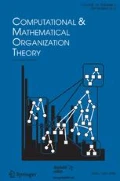Abstract
The concepts of organizational learning in organization and management science cover a very wide range of organization-related activities in organization. Since socially situated intelligence is one of such activities, this paper makes the concept of organizational learning operational from the computational viewpoint for investigating socially situated intelligence. In particular, this paper focuses on the characteristics of multiagent learning as one kind of socially situated intelligence, and analyzes them using four operationalized learning mechanisms in organizational learning. A careful investigation on the characteristics of multiagent learning has revealed the following implications: (1) there are two levels in the learning mechanisms for multiagent learning (the individual level and organizational level) and each mechanism is divided into two types (single- and double-loop learning). The integration of these four learning mechanisms improves socially situated intelligence; and (2) the following properties support socially situated intelligence: (a) different dimensions in learning mechanisms, (b) interaction among various levels and types of learning mechanisms in addition to interaction among agents, and (c) combination of exploration at an individual level and exploitation at an organizational level.
Similar content being viewed by others
References
Agre, P.E. and S.J. Rosenschein (1996), Computational Theories of Interaction and Agency. The MIT Press.
Argyris, C. and D.A. Schon (1978), Organizational Learning. Addison-Wesley.
Barnard, C.I. (1938), The Functions of the Executive. Harvard University Press.
Cohen, M.D. and L.S. Sproull (1995), Organizational Learning. SAGE Publications.
Duncan, R. and A. Weiss (1979), "Organizational Learning: Implications for Organizational Design," in B.M. Staw (Ed.) Research in Organizational Behavior, Vol. 1, JAI Press, pp. 75–123.
Epstein, J.M. and R. Axtell (1996), Growing Artificial Societies. MIT Press.
Espejo, R., W. Schuhmann, M. Schwaninger and U. Bilello (1996), Organizational Transformation and Learning. John Wiley & Sons.
Gasser, L. and A. Bond (1988), Readings in Distributed Artificial Intelligence. Morgan Kaufman Publishers.
Goldberg, D.E. (1989), Genetic Algorithms in Search, Optimization, and Machine Learning. Addison-Wesley.
Grefenstette, J.J. (1988), "Credit Assignment in Rule Discovery Systems Based on Genetic Algorithms," Machine Learning, 3, 225–245.
Holland, J.H. and J. Reitman (1978), "Cognitive Systems Based on Adaptive Algorithms," in D.A.Waterman and F. Hayes-Reth (Eds.) Pattern Directed Inference System. Academic Press.
Ishida, T., Y. Katagiri and K. Kuwabara (1996), Distributed Artificial Intelligence. Corona Publishing Co (in Japanese).
Kim, D. (1993), "The Link Between Individual and Organizational Learning," Sloan Management Review, Fall, 37–50.
Kirn, S. and G. O'hare (1997), Cooperative Knowledge Processing. Springer-Verlag.
March, J.G. (1991), "Exploration and Exploitation in Organizational Learning," Organizational Science, 2(1), 71–87.
Nonaka, I. and H. Takeuchi (1995), The Knowledge Creating Company. Oxford University Press.
Prietula, M.J., K.M. Carley and L. Gasser (1998), Simulating Organizations. AAAI Press/The MIT Press.
Russell, S.J. and P. Norving (1995), Artificial Intelligence: A Modern Approach. Prentice-Hall International.
Smith, S.F. (1983), "Flexible Learning of Problem Solving Heuristics through Adaptive Search," 1983 International Joint Conference on Artificial Intelligence (IJCAI'83), pp. 422–425.
Sutton, R.S. and A.G. Bart (1998), Reinforcement Learning-An Introduction. The MIT Press.
Takadama, K., S. Nakasuka and T. Terano (1998a), "Printed Circuit Board Design via Organizational-Learning Agents," Applied Intelligence: Special Issue on Intelligent Adaptive Agents, Kluwer Academic Publishers, Vol. 9, No. 1, pp. 25–37.
Takadama, K., K. Hajiri, T. Nomura, M. Okada, S. Nakasuka and K. Shimohara (1998b), "Learning Model for Adaptive Behaviors as an Organized Group of Swarm Robots," International Journal of Artificial Life and Robotics, Springer-Verlag, Vol. 2, No. 3, pp. 123–128.
Watkins, C.J.C.H. and P. Dayan (1992), "Technical Note: Q-Learning," Machine Learning, 8, 55–68.
Weiss, G. and S. Sen (1996), Adaption and Learning in Multi-Agent Systems, Lecture Notes in Artificial Intelligence, Vol. 1042, Springer-Verlag.
Weiss, G. (1997), Distributed Artificial Intelligence Meets Machine Learning-Learning in Multi-Agent Environments, Lecture Notes in Artificial Intelligence, Vol. 1221, Springer-Verlag.
Author information
Authors and Affiliations
Rights and permissions
About this article
Cite this article
Takadama, K., Terano, T., Shimohara, K. et al. Making Organizational Learning Operational: Implications from Learning Classifier Systems. Computational & Mathematical Organization Theory 5, 229–252 (1999). https://doi.org/10.1023/A:1009638423221
Issue Date:
DOI: https://doi.org/10.1023/A:1009638423221




